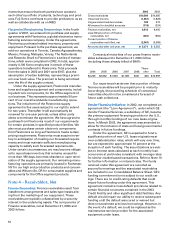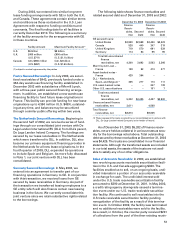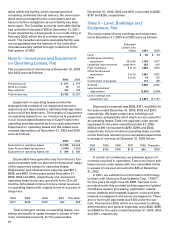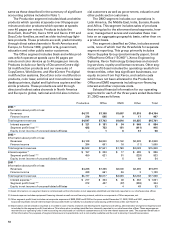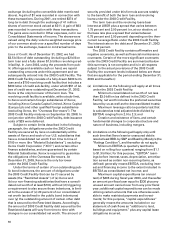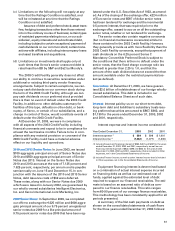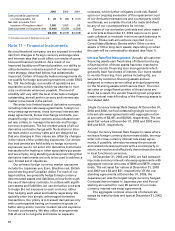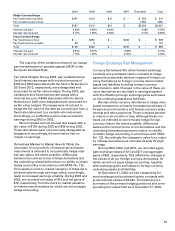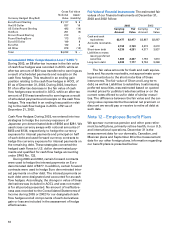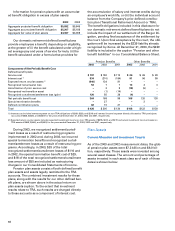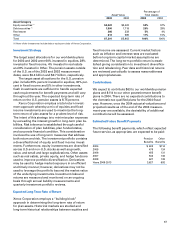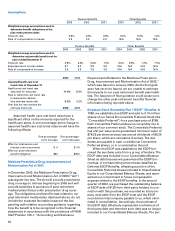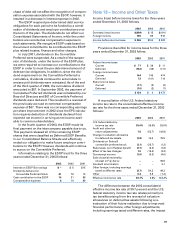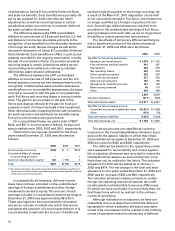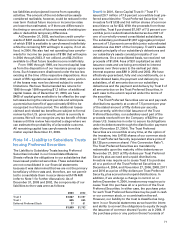Xerox 2003 Annual Report Download - page 63
Download and view the complete annual report
Please find page 63 of the 2003 Xerox annual report below. You can navigate through the pages in the report by either clicking on the pages listed below, or by using the keyword search tool below to find specific information within the annual report.
61
(c) Limitations on the following will not apply at any
time that the Ratings Condition is satisfied, and
will be reinstated at any time that the Ratings
Condition is not satisfied:
Issuance of debt and preferred stock; asset trans-
fers; hedging transactions other than those entered
into in the ordinary course of business; certain types
of restricted payments relating to our, or our sub-
sidiaries’, equity interests and subordinated debt,
including (subject to certain exceptions) payment of
cash dividends on our common stock; certain trans-
actions with affiliates, including intercompany loans
and asset transfers and acquisitions.
(d) Limitations on investments shall apply only at
such times that Xerox’s senior unsecured debt is
rated less than BB by S&P and Ba2 by Moody’s.
The 2003 Credit Facility generally does not affect
our ability to continue to securitize receivables under
additional or existing third-party vendor financing
arrangements. Subject to certain exceptions, we can-
not pay cash dividends on our common stock during
the term of the 2003 Credit Facility, although we can
pay cash dividends on our preferred stock provided
there is then no event of default under the 2003 Credit
Facility. In addition to other defaults customary for
facilities of this type, defaults on other debt, or bank-
ruptcy, of Xerox, or certain of our subsidiaries, and a
change in control of Xerox, would constitute events of
default under the 2003 Credit Facility.
At December 31, 2003, we were in compliance
with all aspects of the 2003 Credit Facility including
financial covenants and expect to be in compliance for
at least the next twelve months. Failure to be in com-
pliance with any material provision or covenant of the
2003 Credit Facility could have a material adverse
effect on our liquidity and operations.
2010 and 2013 Senior Notes: In June 2003, we issued
$700 aggregate principal amount of Senior Notes due
2010 and $550 aggregate principal amount of Senior
Notes due 2013. Interest on the Senior Notes due
2010 and 2013 accrues at the rate of 7.125 percent and
7.625 percent, respectively, per annum and is payable
semiannually on June 15 and December 15. In con-
junction with the issuance of the 2010 and 2013 Senior
Notes, debt issuance costs of $32 were deferred.
These notes, along with our Senior Notes due 2009
which were issued in January 2002, are guaranteed by
our wholly-owned subsidiaries Intelligent Electronics,
Inc. and Xerox International Joint Marketing, Inc.
2009 Senior Notes: In September 2003, we completed
our offer to exchange the €225 million and $600 aggre-
gate principal amount of our 9.75 percent unregistered
senior notes due 2009 for a like principal amount of
9.75 percent senior notes due 2009 that have been reg-
istered under the U.S. Securities Act of 1933, as amend-
ed. As of the closing of the exchange offer, €224 million
of Euro senior notes and $587 of dollar senior notes
had been tendered for exchange and the incremental
0.5 percent interest, that was required prior to the
exchange offer, ceased to accrue on all the outstanding
senior notes, whether or not tendered for exchange.
The senior notes also contain negative covenants
(but no financial maintenance covenants) similar to
those contained in the 2003 Credit Facility. However,
they generally provide us with more flexibility than the
2003 Credit Facility covenants, except that payment of
cash dividends on the 6.25 percent Series C
Mandatory Convertible Preferred Stock is subject to
the conditions that there is then no default under the
senior notes, that the fixed charge coverage ratio (as
defined) is greater than 2.25 to 1.0, and that the
amount of the cash dividend does not exceed the then
amount available under the restricted payments bas-
ket (as defined).
Guarantees: At December 31, 2003, we have guaran-
teed $2.0 billion of indebtedness of our foreign wholly-
owned subsidiaries. This debt is included in our
Consolidated Balance Sheet as of such date.
Interest: Interest paid by us on our short-term debt,
long-term debt and liabilities to subsidiary trusts issu-
ing preferred securities amounted to $867, $903, and
$1,130 for the years ended December 31, 2003, 2002
and 2001, respectively.
Interest expense and interest income consisted of:
Year Ended December 31, 2003 2002 2001
Interest expense (1) $ 884 $ 896 $ 1,001
Interest income (2) (1,062) (1,077) (1,230)
(1) Includes Equipment financing interest of $362, $401 and $457 for the years
ended December 31, 2003, 2002 and 2001, respectively, as well as non-
financing interest expense of $522, $495 and $544 for the years ended
December 31, 2003, 2002 and 2001, respectively, that is included in Other
expenses, net in the Consolidated Statements of Income.
(2) Includes Finance income, as well as other interest income that is included
in Other expenses, net in the Consolidated Statements of Income.
Equipment financing interest is determined based
on a combination of actual interest expense incurred
on financing debt, as well as our estimated cost of
funds, applied against the estimated level of debt
required to support our financed receivables. The esti-
mate is based on an assumed ratio of debt as com-
pared to our finance receivables. This ratio ranges
from 80-90 percent of our average finance receivables.
This methodology has been consistently applied for all
periods presented.
A summary of the Net cash payments on debt as
shown on the consolidated statements of cash flows
for the three years ended December 31, 2003 follows:



